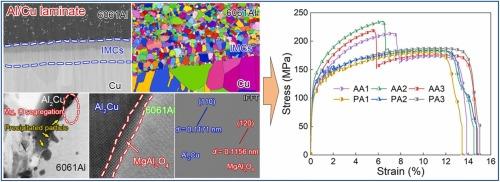合金元素对铝/铜层压板微观结构演变、界面结构和机械性能的影响
IF 6.3
2区 材料科学
Q2 CHEMISTRY, PHYSICAL
引用次数: 0
摘要
采用热压烧结工艺制造了以纯铝或 6061Al 为夹层的铝/铜层压板,并阐明了合金元素对微观结构演变、界面结构和机械性能的影响。结果表明,铝/铜层压板实现了良好的冶金结合,并在铝/铜界面上形成了由 Al4Cu9、Al2Cu 和 AlCu 相组成的金属间化合物层。镁元素促进了铜原子的富集,并为 Al2Cu 提供了成核点,从而在 6061Al/Cu 薄片中形成了较厚的 Al2Cu 相和大量分散的 Al2Cu 颗粒。MgAl2O4 相沿 6061Al/Al2Cu 界面分布,与 6061Al 和 Al2Cu 都呈现出相干关系,有助于增强位错运动的阻力和载荷传递的有效性。在使用纯铝作为夹层的铝/铜层压板的拉伸变形过程中,裂纹更容易穿过铝/铝2Cu界面传播到铝层。当使用 6061Al 作为夹层时,整体拉伸强度更高,拉伸曲线显示出两个明显的应力下降。此外,裂纹在扩展过程中穿过 6061Al/Al2Cu 界面时面临更大的阻力,并倾向于沿着 6061Al/Cu 界面扩展,呈现出明显的分层断裂形态。本文章由计算机程序翻译,如有差异,请以英文原文为准。

Effects of alloying elements on microstructure evolution, interfacial structure, and mechanical properties of Al/Cu laminate
Hot press sintering process was employed to fabricate the Al/Cu laminates with pure Al or 6061Al as interlayer, and the effects of alloying elements on microstructure evolution, interfacial structure, and mechanical properties were clarified. A good metallurgical bonding was achieved and intermetallic compounds layers consisting of Al4Cu9, Al2Cu, and AlCu phases formed at the Al/Cu interface. Mg element facilitated the enrichment of Cu atoms and provided the nucleation sites for Al2Cu, resulting in a thicker Al2Cu phase and numerous dispersed Al2Cu particles in 6061Al/Cu laminate. MgAl2O4 phase distributed along 6061Al/Al2Cu interface, and it exhibits a coherent relationship with both 6061Al and Al2Cu, which contributed to enhancing the resistance of dislocation movement and the effectiveness of load transfer. During the tensile deformation of Al/Cu laminate using pure Al as the interlayer, the cracks were more likely to propagate across the Al/Al2Cu interface into the Al layer. When 6061Al was used as interlayer, the overall higher tensile strength was achieved, and the tensile curves showed two distinct stress drops. Moreover, the cracks faced greater resistance when traversing the 6061Al/Al2Cu interface during the expansion, and they tended to extend along the 6061Al/Cu interface, showing a distinct delamination fracture morphology.
求助全文
通过发布文献求助,成功后即可免费获取论文全文。
去求助
来源期刊

Journal of Alloys and Compounds
工程技术-材料科学:综合
CiteScore
11.10
自引率
14.50%
发文量
5146
审稿时长
67 days
期刊介绍:
The Journal of Alloys and Compounds is intended to serve as an international medium for the publication of work on solid materials comprising compounds as well as alloys. Its great strength lies in the diversity of discipline which it encompasses, drawing together results from materials science, solid-state chemistry and physics.
 求助内容:
求助内容: 应助结果提醒方式:
应助结果提醒方式:


